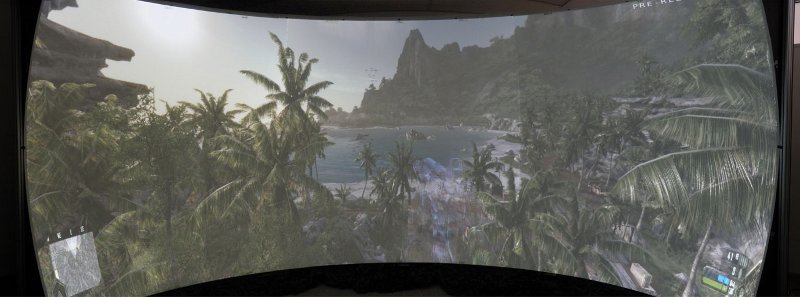Hmm. Really interesting thoughts you have here. I myself have thought about this, and I think I know what your getting at with this "flat" view stuff. I was bored one day in 3D Studio Max and maximized it to all 3 screens, and in an orthographic view I get no distortion on the sides - is this what your referring to?
While this would in fact work, orthographic or isomeric views eliminate the "illusion" of perspective, where objects vanish to points in space. In an isometric view, parallel lines remain parallel and do not vanish to such points, which greatly takes away from that illusion of perspective, effectively making the world you see feel flat and lifeless. Field of view isn't even a factor in an orthographic view (the FOV option actually is actually disabled when working in such a view in 3ds MAX/Maya). I don't really think that would be appropriate for anything besides maybe an RTS, if that. To demonstrate what I mean, I quickly modeled a few boxes and threw some textures on them:
Orthographic:

Perspective:

As you can see, the orthographic view looks very flat and it is hard to decipher the depth of the scene. Infact, if you took the boxes out of the picture that indicated that they the surface they were on was the floor, it's hard to tell if that surface is concave, or convex. It looks both like a box lit from the bottom left, or a room lit from the top right.

Though, in perspective, because of how we interpret perspective drawings/renderings, we can immediately recognize that it is a concave area, with the walls in the back.

I do a lot of perspective drawing, and the edge distortion isn't something that is limited to games or 3d applications, any illusion of depth in on any flat surface, unless it is an isometric view, is going to have edge distortion. Even in a multi-point perspective drawing, as lines grow nearer to the edge of the drawing (and their vanishing points) they skew and distort, becoming wider/shorter than they truly are. And just like multi-monitor gaming, if I have a very wide drawing, and place my vanishing points even further apart, that distorting becomes even more apparent. While they are not exactly the same, a video game is basically just a perspective drawing, at it's most simple levels.
Like dopefish said, the only real way of getting a perspective view without the fisheye, that would imitate things as we see them in life with our own eyes, is with multiple frustums. Even so, one must consider the edge distortion we seen on only one screen; it would look sort of odd as it stretched and then unstretched from monitor to monitor. No doubt, we could probably find a way around that by lowering our FOV to minimize edge distortion seen on single screens, but support like that from developers today is wishful thinking, it can be hard enough to get them to support multi-monitor gaming in it's current state (we have a lobbying section dedicated to it!) and those developers that wave the "not fair!" flag would go bananas if we even mentioned something like that to them.
Though, on a sidenote, one way to sort of get rid of the fisheye is to play with projectors on a curved surface with nthusim, the fisheye looks much more natural in that setup, from the Nthusim site. Though, the hud is pretty distorted.

Makes me wonder if I could use Nthusism to do the same thing with monitors? I guess that would just be doing what you did in that one screen shot, artificially removing the fisheye in realtime, but also making the view slightly less wide. I could deal with that though. Interesting thought..
Another way I suppose that would work, is to well, take a game that was Hor+, and make it Vert-, then pull the camera out to a point that the viewable space vertically is equal to that of the space in a 4:3 screen. Though, I imagine that with such a low FOV it would still feel odd.





